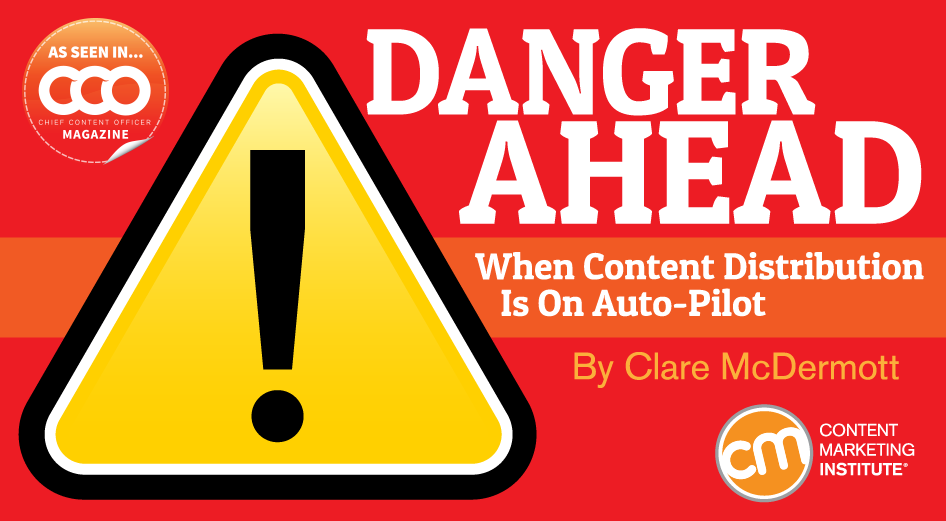
Andy Crestodina is the co-founder of Orbit Media and one of the best teachers we know when it comes to search engine optimization, email marketing, and social media. In this interview, he speaks plainly about why great content creators don’t always come out ahead, and the dangers of putting your content distribution strategies on autopilot.
CCO: Three years ago, the content marketing mantra was something like, ‘If you build it, they will come.’ Yet more and more, I see marketers paying a lot of attention to what comes after creation. What matters more?
Crestodina: Quality is a deal breaker. Low-quality content can’t be helped by any effort. No amount of promotion will help a bad piece of content get more traffic, engage more visitors, or attain higher ROI. Quality is a necessary baseline.
But there is not necessarily a correlation between high-quality content and traffic. An OK piece of content that is promoted brilliantly will outperform brilliant content with just OK promotion. There is no doubt in my mind about that. The winners are those who are great promoters. Great creators are not necessarily going to come out on top.
It’s common – especially for bloggers – to publish something, share it on Twitter and Facebook, and then move on to the next piece of content. They spend 80% of their time on content and 20% of their time marketing it.
They’re slaves to the publishing calendar. To get better results, they speed up the publishing schedule but do not change their tactics for promotion. Endlessly sharing via social media and emailing to a list are not nearly as powerful as a plan to get large-scale sharing or a plan to aggressively grow your list.
The winners in content marketing are those who are good at influencer marketing, list growth, and keyword research/usage. Those are the most important tactics for the three main traffic channels: social, email, and search.

RECOMMENDED FOR YOU:
CCO: I see influencer marketing, list growth, and SEO as tech-driven. True?
Crestodina: There’s a science to it and tools for each, but I don’t think you need technology to do any of those three. You only need basic tools. Simple programming and web design tricks will give you list growth. And you don’t need to use influencer-marketing platforms.
It’s not really about the tools; it’s what you do with them. Imagine you want more friends in life. Would you say, “I need to get better at communicating. I’m going to buy a better phone?” No. You can’t automate getting new friends. The same is true for growing your audience.
Here’s a classic example: A lot of marketers use a plug-in from WordPress to manage keywords. Every time they write something, they are careful to use certain keywords in the headline and body text, use meta tags, etc. The plug-in tells them to use the keyword “x” many times. The visual meter on the screen goes from red to green when they’ve filled the quota. That is a crazy way to do SEO because it doesn’t take into account the likelihood of ranking for that phrase. No matter how and where you use the phrase, you will lose if you’re not in the same range of authority and link popularity as the other high-ranking sites for the phrase.
Marketers who try to ram in keywords – and particularly those targeting a phrase for which they have zero chance to rank – show a fundamental lack of understanding of what works. It’s depressing in the long run.
Another mistake is choosing a keyword(s) because it has the biggest search value. If someone sees that one phrase gets 100 searches per month versus another with 10,000 searches per month, they think the second phrase is better. But this isn’t always true. People want a prescriptive answer, but it’s not that simple.
The gap between good and great isn’t a quality gap; it’s a promotion gap. Great content requires an understanding of why people visit a particular website, how headlines work, the role of images and colors – basically the psychology of web searches and content consumption.
Let me offer an example. You may want to know: What is the best format and topic for downloads that will get people to give you an email address? The answer? A list of tools in a PDF format. It may vary audience by audience, but evidence shows the ideal ethical bribe to get a visitor to subscribe (i.e., share an email address) is a PDF with a list of tools. Those who don’t try it will have slower list growth.
Promotion savvy requires an analytical – even technical – skill set. You need to be a hacker of psychology and search. There’s little opinion involved. Judging the quality of content is squishy, but knowing which actions lead to which outcomes for traffic and promotion is not that squishy.
This article originally appeared in the October issue of Chief Content Officer. Sign up to receive your free subscription to CMI’s bimonthly, print magazine.
Cover image by Joseph Kalinowski/Content Marketing Institute

